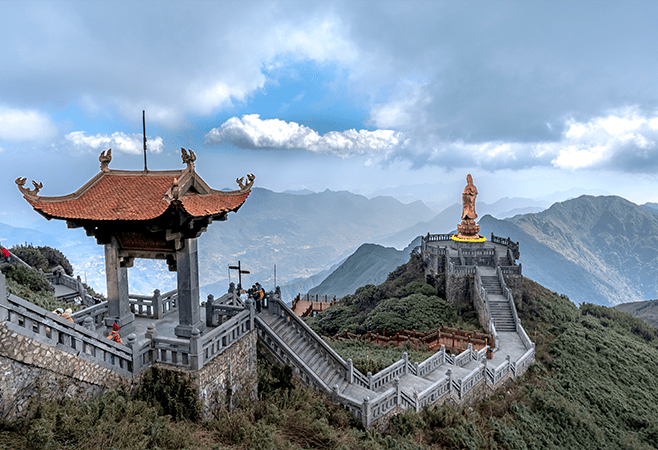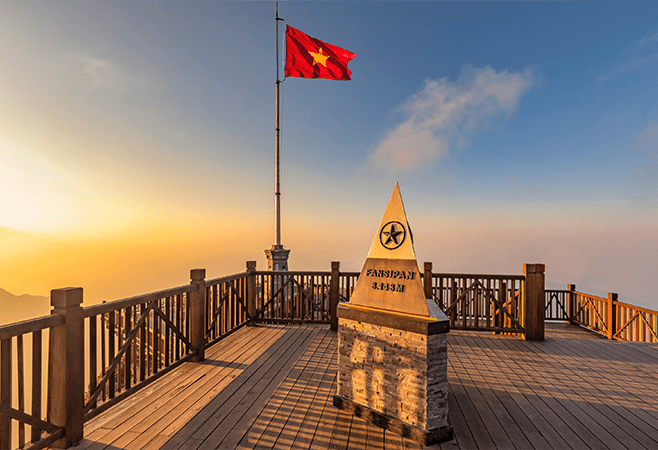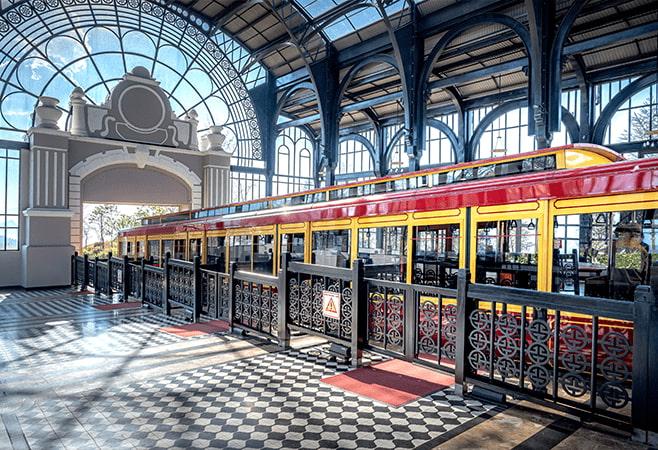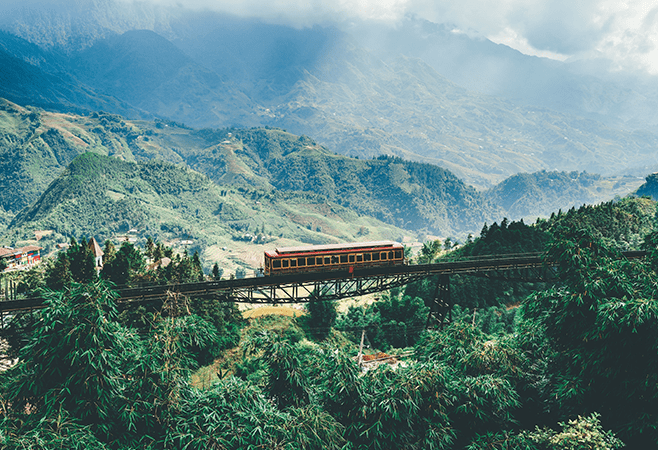Fansipan Mountain: Journey to the Top of Indochina
The Fansipan Mountain is in the Hoang Lien Son range in Vietnam and is the highest mountain with a height of 3,147.3m or 10,326ft. This mountain is called the “Roof of Indochina”, and when one looks at this mountain, he or she will not fail to feel reverence and spirituality. Being a mountain, Fansipan embraces different ecosystems, culture, and beautiful wonders of nature which makes it not only a destination but a feeling.
This mountain carries many legends of the past which are associated with the indigenous people who regard it as a place of worship and also the contemporary climbers who undertake the journey for tourism or religious purposes. Whether you get to the top by climbing through steep mountains or by riding a cable car high above the clouds, Fansipan is a beautiful sight and a great accomplishment. It is a place where one can feel the spirit of the adventurous and mythical creature, where the woods come alive in the form of a mist and where nature presents her best side.
- Where is Fansipan Mountain located?
- Fansipan Mountain: The Roof of Indochina
- The mythology and legends of Fansipan
- Cultural importance of Fansipan Mountain
- The geological evolution of Fansipan
- Climate and best time to visit Fansipan
- Biodiversity on Fansipan Mountain
- Trekking to the Summit: What to Expect
- Popular Trekking Routes and Trails
- Cable car journey to the summit
- Sun World Fansipan Legend: The Full Experience
- Accommodations in and Around Sapa
- FAQs about Fansipan Mountain
- Conclusion: Fansipan Mountain in Sapa, Vietnam

Looking at Fansipan mountain peak at an altitude of 3,147.3m in Sa Pa town, Lao Cai province, Vietnam
Where is Fansipan Mountain located?
It is located in the Lao Cai Province, near the China border and 9 kilometers from Sapa town which is a beautiful town in northern Vietnam that has a temperate climate and is inhabited by ethnic groups.
It is a part of Hoang Lien Son mountain range which is a section of the eastern Himalayas in the north western part of the country. Despite all that, Fansipan is not really remote anymore, thanks to the new roads, guided tours, and of course the new cable car system. For those who are coming from Hanoi, Fansipan can be reached about 315 km away which can be reached by train or sleeper bus to Sapa then take a car for about 10 minutes.
Fansipan Mountain: The Roof of Indochina
Located in Lao Cai province, Vietnam, Fansipan Mountain is standing at 3,147.3m (10,326 ft) above sea level and is the highest peak not only in Vietnam, Laos, but also Cambodia that is why Fansipan is called the Roof of Indochina. For the tourists, this is not simply a landscape, but a historical and cultural site as well. It is a chance to see the wild and unspoiled side of Southeast Asia that one cannot fail to marvel at.
But what makes it so appealing to the adventurers and other tourists? The answer is in its topography, otherworldly beauty and an historical and cultural importance to the people that inhabit the region. Unlike most other peaks of the world which are either dangerous or over-commercialized, Fansipan is in a league of its own. captured nature with accessibility to the main and additional infrastructures.
For the more adventurous hikers, there are some steep tracks from Tram Ton or Sin Chai villages while those who do not fancy hiking can take a record cable car ride to get to the top in 15 - 20 minutes going through valleys and waterfalls. As one climbs up the Fansipan, it is easy to understand why it is much more than just a destination, it is a journey through the clouds, a mythological experience and a step closer to the soul of Vietnam.
The mythology and legends of Fansipan
Want to know more about the legends that are told around the Fansipan mountain? This mountain is not just the tallest one – it has the stories of generations that have been passed from one generation to another.
It is speculated that the name Fansipan (Phan Xi Pang) may have originated from the word Hua Xi Pan which in the local dialect translates to a “tottering giant rock”. However, moving away from etymology, the mountain is associated with many legends of different ethnic groups. Some people assert that it is inhabited by spirits who have lived in the area since time immemorial.
Tribe people such as Hmong, Dao and Tay indigenous people believe in spirits residing in the thick bamboo forest and some of them pray before going for a hike. Spirituality can be felt here – it is not rare to meet fountains, shrines, and even offerings on the trail. It is not only a haven for the lovers of nature and wildlife but also for those looking for a spiritual connection and self-reflection.
For those people who are interested in culture together with the view and sceneries, knowing the folklore of Fansipan brings more essence to the trip – turning it into a spiritually significant one.
Cultural importance of Fansipan Mountain
It is not just sightseeing in which tourists come to enjoy the scenery but actually a way to explore the ethnic culture in Vietnam. Fansipan is situated in the area inhabited by over thirty ethnic groups, the largest of which are Hmong and Dao.
These people have coexisted with the mountain for centuries, and its presences are reflected in their rituals and even in their daily lives. When with the Fansipan people one can learn about their way of life, the type of clothes they wear, the type of farming they engage in and how they concisely the nature.
Most tourists usually visit the nearby villages in order to eat their meals and engage in rice farming, dancing among other activities. Such interactions enable the visitors not only to watch but to participate and appreciate cultural practices – responsible tourism is promoted.
For instance, those who visit during Tet or the Gau Tao Festival are entertained through music and dance, and are also privileged to watch the ceremonial ritual of paying respect to their ancestors. Thus, Fansipan is not only about the height – it is about opening your eyes and mind to the richness of Vietnam.

The peak of Fansipan mountain 3,147.3m is the highest in Vietnam
The geological evolution of Fansipan
For the geologist and for those who prefer to walk and climb up and down the mountain, Fansipan is significant because it reveals a great deal about what happened millions of years ago on the territory of Vietnam. This mountain has taken millions of years to form through the process of rifting of the Indian and Eurasian tectonic plate which also gave rise to the Himalayas. Thus, Fansipan is similar to these legendary mountains in the sense of geology as well.
The mountain is made of granitic and metamorphic rock that gives an insight into the work of the creator. There are deep valleys and steep cliffs created due to the action of erosion and dynamic plates continue to influence its geography.
Geological tours or eco-guides can give the visitor an understanding of the rock surface, which means that the walk is not only a physical challenge, but also a learning experience. It’s as exciting as it is informative for those interested in earth sciences to pay a visit to Fansipan.
Climate and best time to visit Fansipan
Planning the perfect trip to Fansipan Mountain? Timing is everything. Due to its high elevation, the mountain enjoys a cool, misty climate year-round, but conditions can vary dramatically.
Best months for tourism:
- March to May (Spring): Ideal for flower blooms, especially the rhododendron forests.
- September to November (Autumn): Crisp skies and panoramic visibility - perfect for photography.
- Avoid: June to August, as the monsoon season brings heavy rain and limited visibility. Winter (December to February) can be magical, with the rare appearance of snow, but trails may become icy and treacherous.
Tourists are advised to check local weather forecasts before departure. Fog can roll in suddenly, changing trail conditions and obscuring views. Still, the mountain’s ever-changing climate only adds to its mystique, offering different shades of beauty depending on the season.
Biodiversity on Fansipan Mountain
Fansipan Mountain is a sanctuary for wildlife and flora, which makes it a paradise for eco-tourists and nature photographers. Part of the Hoang Lien National Park, the area is designated as one of Vietnam’s most significant biodiversity hubs.
Here's what tourists can expect to find:
- Flora: Over 2,000 plant species, including rare orchids, medicinal herbs and vibrant rhododendrons.
- Fauna: Clouded leopards, red pandas and more than 300 bird species, some of which are endemic to the region.
Many organized tours include guided nature walks with conservation experts who explain how these ecosystems function and the importance of sustainable tourism. With climate change threatening high-altitude habitats, every eco-conscious visit contributes to awareness and conservation.

Stunning scenery with mountain views in Sapa city, Vietnam
Trekking to the summit: What to expect
If you are the kind of person who wants to have an adventurous experience, then Fansipan trekking is what you should consider. It is not only a physical but an emotional trip as well, an activity which may take hours or days and at the end of it all, Fansipan gives tourists the best scenic views, an opportunity to interact with other people and the amazing feeling of conquering the Fansipan Peak.
Most of the trekking trails originate from Tram Ton Pass or the Heaven’s Gate which is at an altitude of 1,900 meters. It is also the simplest of all the trails for the average hikers and will take roughly 2 days to complete the whole trail. For the more daring hikers, there is the Sin Chai trail which is slightly longer and the trail passes through the jungle. All the trails are interesting, it offers a bamboo forest and valleys of rhododendron, ethnic villages are also found in the area.
Tours are arranged by companies like Viettrekking, which is a company that offers guided and safe trekking to Mount Fan Si Pan. They may also hire porters, food and water, and guides familiar with the land and its legends.
For those who prefer to travel independently, one has to get a permit from the tourism authority, and travel on trails that are designated.
Note: Most first-time trekkers complete the hike in 2 days. A 1-day climb is possible but physically demanding and requires an early start with an experienced guide.
Popular trekking routes and trails
Planning your mount Fansipan hike? Here’s a quick look at the most popular routes:
| Route Name | Starting Point | Difficulty | Duration | Highlight |
| Tram Ton Pass | Tram Ton Station | Moderate | 1–2 Days | Scenic vistas, well-maintained trail |
| Sin Chai Route | Sin Chai Village | Hard | 2–3 Days | Dense jungle, fewer tourists |
| Cat Cat Village Trail | Cat Cat Village | Moderate-Hard | 1.5 Days | Ethnic culture, rice terraces |
Each trail gives you a different taste of Vietnam’s mountainous soul. For those up to the task, the Fan Si Pan hike is as much about the journey as it is the destination.
Cable car journey to the summit
If the idea of hiking doesn’t appeal to you, don’t worry. The Fansipan Mountain Cable Car - known officially as the Sun World Fansipan Legend Cable Car - offers a thrilling and scenic alternative to trekking. This high-tech marvel makes it possible for travelers of all ages and physical abilities to reach the summit with ease.
Operated by SunWorld Fansipan, the cable car to Fansipan spans over 6.3 kilometers, setting two Guinness World Records: the longest three-rope cable car and the greatest elevation difference by a cable car. From Fansipan Station in Sapa, the ride takes just 15–20 minutes and rises over 1,400 meters to the summit complex near Fansipan Peak.
During the ascent, you'll glide above valleys, rice terraces and thick forests - all unfolding like a living painting. The views alone justify the Fansipan cable car cost, which ranges from 700,000 to 800,000 VND per adult (around $28–32 USD), with discounts for children and groups. Many local operators include Fansipan cable car tickets as part of a full tour package that includes pickup from hotels.
Fansipan cable car opening hours
- Daily: 7:30 AM – 5:30 PM
- Best time to ride: Early morning (to catch sunrise) or late afternoon (for golden hour views)
Don’t forget to take a few moments at the Fansipan Station before boarding - the architecture alone is a sight to behold, with its blend of modern design and traditional motifs inspired by Vietnamese culture.
Note: Operating hours may vary due to weather and seasonal schedules. Always confirm in advance.

Railway station serving tourists taking the cable car to the top of Fansipan mountain
Sun World Fansipan Legend: The full experience
The entire Sun World Fansipan experience is much more than a cable car ride. It's a cultural and spiritual retreat nestled among the clouds. After that, a network of stone roads, stairs, and service lifts will lead you through a set of impressive sights such as the Great Buddha statue, Bich Van Zen Monastery, and the Dai Hong Chung Bell Tower.
One of the interesting things that can be seen on the mountain is the Fansipan Buddha which is a bronze statue that is 21.5 meters tall and is one of the tallest statues in Vietnam. Designed to harmonize with the environment it is located in, it is frequently shrouded in mist, giving it a heavenly look.
SunWorld Fansipan Legend is one of the most family-friendly sites in Vietnam where comfort, cultural and adventurous tourism are perfectly intertwined.
Accommodations in and Around Sapa
Whether you're hiking or riding the Fansipan cable car, staying in Sapa provides the best base for exploration. This bustling mountain town offers a wide range of accommodations to suit every budget.
- Eco Lodges: For nature lovers seeking seclusion and stunning views.
- Boutique Hotels: Stylish and centrally located, great for couples.
- Homestays: Perfect for cultural immersion with Hmong or Dao families.
- Luxury Resorts: Like the Silk Path Grand Resort & Spa, offering 5-star amenities and sweeping vistas.
If you're planning a Fansipan trekking tour, we highly recommend arriving in Sapa at least one day before your expedition to acclimate and explore the local markets.
FAQs about Fansipan Mountain
- How long does it take to hike to the top of Fansipan?
Depending on your chosen trail, a trek can take between 1 to 3 days. Tram Ton is the most beginner-friendly route.
- Is the Fansipan cable car safe?
Yes, it's operated by SunWorld Fansipan, maintained to international safety standards and recognized by Guinness World Records.
- Can I visit Fansipan without a guide?
Trekking independently is possible but requires a permit and knowledge of the terrain. Guided tours are highly recommended.
- What's the best month to visit Fansipan?
March to May and September to November offer the best weather and visibility.
- What should I wear when visiting Fansipan?
Layered clothing is essential due to temperature shifts. Waterproof gear is also advisable.
- Are there restaurants near the summit?
Yes, several cafés and food kiosks are available at the summit complex operated by FansipanLegend.

Beautiful landscape with mountain view on the train while going to Fansipan mountain
Conclusion: Fansipan Mountain in Sapa, Vietnam
Fansipan Mountain is more than Vietnam's highest peak - it's a doorway into the soul of a region steeped in tradition, nature and awe-inspiring beauty. Whether you're scaling its heights on foot through dense forests or ascending with ease aboard the cable car to Fansipan, your journey to this sacred summit promises memories that will last a lifetime.
With cultural depth, breathtaking biodiversity and modern conveniences like Sun World Fansipan Legend, the mountain invites travelers of all stripes to touch the sky - literally and spiritually. So, gear up, grab your camera and make your way to the Roof of Indochina. You won’t just visit Mount Fan Si Pan; you’ll become a part of its living legend.
Related Articles
- Moc Chau: Highland paradise of tea hills & cultural adventures
- Team building and CSR activities in Vietnam: Visa services
- Honeymoon in Vietnam: Best romantic packages for couples
- Amanoi Resort in Vietnam: Luxury retreat in Vinh Hy Bay
- Six Senses resorts in Vietnam: Ninh Van Bay and Con Dao
- Con Dao Island: A historical and natural paradise in Vietnam
- Michelin Guide in Vietnam: Ho Chi Minh City, Da Nang, Hanoi
- Vietnam vs Thailand: A comparison for Southeast Asia escape
HOW CAN WE HELP?
APPLY WITH CONFIDENCE










